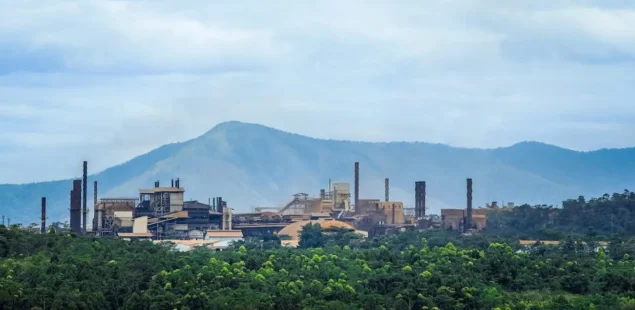
BloombergNEF, energy-research firm, and Microsoft, cloud operator, have put hard numbers on the data-center pull on copper: BNEF estimates demand from the sector will average 400,000 t a year over the next decade, peaking at 572,000 t in 2028 and reaching a cumulative 4.3 Mt in use by 2035—layers of new consumption that could stretch an already tight market into a 6 Mt deficit by 2035. Microsoft’s Chicago build alone used 2,177 t of copper, underscoring the scale at site level. Spot prices have cooled since a late-July tariff shock, with Comex around $4.49/lb ($9,900/t).
AI buildout adds a new load to a tight balance
BNEF frames data-center growth as additive to established electrification drivers: grids, transmission, and renewables. It expects copper use in power transmission and wind to nearly double by 2035, with AI facilities adding a structurally higher base load. On BNEF’s arithmetic, global supply at ~29 Mt in 2035 would lag the ~35 Mt needed, even before accounting for operational risks at large mines. The supply gap reflects years of underinvestment and long project lead times, not a single-factor surge.
Where the metal goes inside a data center
Copper’s electrical and thermal conductivity make it ubiquitous: high-amp power cables and busbars from substations to server rows; connectors and switchgear; heat exchangers and sinks for high-density racks; and distribution strips across halls. Case studies commonly cite tens of tonnes per megawatt of IT load, with the Chicago facility’s 2,177-t bill of materials a frequently referenced benchmark. North American data-center infrastructure, a proxy for physical build, is projected to scale from ~$33 bn in 2020 to ~$70 bn in 2030 and ~$185 bn in 2040.
Prices and near-term market signals
Copper rallied into the spring before a tariff-policy whipsaw in late July drove a sharp unwind in New York, erasing a premium over London as the White House narrowed the scope to semi-finished products and excluded raw copper. Futures tumbled roughly a fifth on the day; by this week Comex hovered near $4.49/lb, while LME three-month traded close to the $9,600–$9,800/t band. The policy-induced volatility arrived just as traders were repricing longer-dated balances on AI and grid demand, leaving macro signals and physical premia at odds.
Industry context and applications
The sector’s ability to clear the BNEF-flagged shortfall depends on mine restarts, brownfield debottlenecking, and permitting for greenfield projects whose paybacks hinge on durable price support. Recent disruptions—from Chilean underground stoppages to African ramp-up hiccups—highlight execution risk in meeting mid-decade needs for both concentrates and refined metal. Against that backdrop, hyperscalers’ procurement teams are tightening specifications for verified metal content across cables, switchgear and cooling systems, pushing cost and schedule sensitivity upstream. (Microsoft’s Chicago project is an early, widely cited example of copper intensity.)
Company Background and Market Context
BloombergNEF, a Bloomberg unit, publishes long-range scenarios for energy and materials; its latest copper analysis isolates AI data-center demand as a distinct end-use alongside transmission and renewables. Microsoft’s Chicago facility, frequently referenced by miners and policymakers, illustrates the per-site tonnage that can accrue when power distribution and thermal systems scale with AI workloads. Visual Capitalist’s sector synthesis places the North American buildout on a multi-decade growth path, amplifying the structural demand case set out by BNEF.
Copper is central to electrification across grids, transport and industry. Prices have pulled back from spring highs but remain historically elevated; near-term moves hinge on tariff clarity and mine-site reliability, while medium-term balances are shaped by AI- and grid-driven capital spending that is difficult to throttle once underway.



